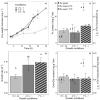Potential for the Production of Carotenoids of Interest in the Polar Diatom Fragilariopsis cylindrus
- PMID: 36005496
- PMCID: PMC9409807
- DOI: 10.3390/md20080491
Potential for the Production of Carotenoids of Interest in the Polar Diatom Fragilariopsis cylindrus
Abstract
Carotenoid xanthophyll pigments are receiving growing interest in various industrial fields due to their broad and diverse bioactive and health beneficial properties. Fucoxanthin (Fx) and the inter-convertible couple diadinoxanthin-diatoxanthin (Ddx+Dtx) are acknowledged as some of the most promising xanthophylls; they are mainly synthesized by diatoms (Bacillariophyta). While temperate strains of diatoms have been widely investigated, recent years showed a growing interest in using polar strains, which are better adapted to the natural growth conditions of Nordic countries. The aim of the present study was to explore the potential of the polar diatom Fragilariopsis cylindrus in producing Fx and Ddx+Dtx by means of the manipulation of the growth light climate (daylength, light intensity and spectrum) and temperature. We further compared its best capacity to the strongest xanthophyll production levels reported for temperate counterparts grown under comparable conditions. In our hands, the best growing conditions for F. cylindrus were a semi-continuous growth at 7 °C and under a 12 h light:12 h dark photoperiod of monochromatic blue light (445 nm) at a PUR of 11.7 μmol photons m-2 s-1. This allowed the highest Fx productivity of 43.80 µg L-1 day-1 and the highest Fx yield of 7.53 µg Wh-1, more than two times higher than under 'white' light. For Ddx+Dtx, the highest productivity (4.55 µg L-1 day-1) was reached under the same conditions of 'white light' and at 0 °C. Our results show that F. cylindrus, and potentially other polar diatom strains, are very well suited for Fx and Ddx+Dtx production under conditions of low temperature and light intensity, reaching similar productivity levels as model temperate counterparts such as Phaeodactylum tricornutum. The present work supports the possibility of using polar diatoms as an efficient cold and low light-adapted bioresource for xanthophyll pigments, especially usable in Nordic countries.
Keywords: blue light; diadinoxanthin; diatoxanthin; fucoxanthin; photosynthesis; polar diatoms.
Conflict of interest statement
The authors declare no conflict of interest. The funders had no role in the design of the study; in the collection, analyses, or interpretation of data; in the writing of the manuscript, or in the decision to publish the results.
Figures









Similar articles
-
Valorization of Phaeodactylum tricornutum for integrated preparation of diadinoxanthin and fucoxanthin.Bioresour Technol. 2023 Oct;385:129412. doi: 10.1016/j.biortech.2023.129412. Epub 2023 Jun 28. Bioresour Technol. 2023. PMID: 37390934
-
Combined artificial high-silicate medium and LED illumination promote carotenoid accumulation in the marine diatom Phaeodactylum tricornutum.Microb Cell Fact. 2019 Dec 2;18(1):209. doi: 10.1186/s12934-019-1263-1. Microb Cell Fact. 2019. PMID: 31791335 Free PMC article.
-
Long-term temperature acclimation of photosynthesis in steady-state cultures of the polar diatom Fragilariopsis cylindrus.Photosynth Res. 2005 Sep;85(3):307-17. doi: 10.1007/s11120-005-5668-9. Photosynth Res. 2005. PMID: 16170633
-
Carotenoid biosynthesis in diatoms.Photosynth Res. 2010 Nov;106(1-2):89-102. doi: 10.1007/s11120-010-9589-x. Epub 2010 Aug 24. Photosynth Res. 2010. PMID: 20734232 Review.
-
Photosynthetic Pigments in Diatoms.Mar Drugs. 2015 Sep 16;13(9):5847-81. doi: 10.3390/md13095847. Mar Drugs. 2015. PMID: 26389924 Free PMC article. Review.
Cited by
-
Charting the state of GEMs in microalgae: progress, challenges, and innovations.Front Plant Sci. 2025 Jun 13;16:1614397. doi: 10.3389/fpls.2025.1614397. eCollection 2025. Front Plant Sci. 2025. PMID: 40584862 Free PMC article. Review.
References
-
- Zarekarizi A., Hoffmann L., Burritt D. Approaches for the sustainable production of fucoxanthin, a xanthophyll with potential health benefits. J. Appl. Phycol. 2018;31:281–299. doi: 10.1007/s10811-018-1558-3. - DOI
-
- Arora N., Philippidis G.P. Algae: Multifarious Applications for a Sustainable World. Springer; Singapore: 2021. Fucoxanthin Production from Diatoms: Current Advances and Challenges; pp. 227–242.
-
- Seth K., Kumar A., Rastogi R.P., Meena M., Vinayak V. Harish, Bioprospecting of fucoxanthin from, 102475.diatoms—Challenges and perspectives. Algal Res. 2021;60:102475. doi: 10.1016/j.algal.2021.102475. - DOI

